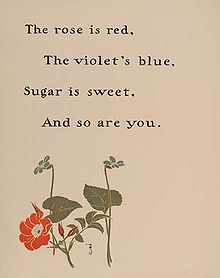Roses Are Red
| "Roses Are Red" | |
|---|---|
 William Wallace Denslow's illustrations for "Roses are red", from a 1901 edition of Mother Goose | |
| Nursery rhyme | |
| Written | 1784 |
"Roses Are Red" is the name of a classic children's rhyming poem. It is also a class of poems inspired by that poem. It has a Roud Folk Song Index number of 19798.[1] It is most commonly used as a love poem.
Roses are red,
Violets are blue,
Sugar is sweet,
And so are you.
Origins
The verse "Roses are red" echoes conventions traceable as far back as Edmund Spenser's epic The Faerie Queene (1590):
A nursery rhyme significantly closer to the modern cliché Valentine's Day poem can be found in Gammer Gurton's Garland, a 1784 collection of English nursery rhymes:
Victor Hugo was likely familiar with Spenser, but may not have known the English nursery rhyme when, in 1862, he published the novel Les Misérables. Hugo was a poet as well as a novelist, and within the text of the novel are many songs. One sung by the character Fantine contains this refrain, in the 1862 English translation:
We will buy very pretty things
A-walking through the faubourgs.
Violets are blue, roses are red,
Violets are blue, I love my loves.
This translation replaces the original version's cornflowers ("bleuets") with violets, and makes the roses red rather than pink, effectively making the song closer to the English nursery rhyme. The last two lines in the original French are:
Les bleuets sont bleus, les roses sont roses,
Les bleuets sont bleus, j'aime mes amours.
(Les Misérables, Fantine, Book Seven, Chapter Six)[4]
Folklore
Numerous satirical versions have long circulated in children's lore.[5] Among them:
Roses are red.
Violets are blue.
Onions stink.
And so do you.[6]
Country music singer Roger Miller parodied the poem in a verse of his 1964 hit "Dang Me":
They say roses are red and violets are purple
Sugar's sweet and so is maple syruple. [sic][7]
The Marx Brothers' film Horse Feathers has Chico Marx describing the symptoms of cirrhosis thus:
Cirrhosis are red,
so violets are blue,
so sugar is sweet,
so so are you.[8]
Benny Hill version:
Roses are yellow
Violets are bluish
If it weren't for Christmas
We'd all be Jewish[9]
Notes
- ^ "Roud Folksong Index S299266 Roses are red, violets are blue". Vaughan Williams Memorial Library. English Folk Dance and Song Society. Retrieved May 20, 2016.
- ^ Spenser, The Faery Queene iii, Canto 6, Stanza 6: on-line text Archived March 4, 2016, at the Wayback Machine
- ^ I. Opie and P. Opie (1951). The Oxford Dictionary of Nursery Rhymes (1997, 2nd ed.). Oxford University Press. p. 375.
- ^ "Les misérables, Tome I by Victor Hugo". Project Gutenberg.
- ^ S. J. Bronner, American Children’s Folklore (August House: 1988), p. 84.
- ^ Liz Gooch (18 May 2005). "Jill Still Playing Jacks And Hopscotch Endures". Retrieved 17 September 2009.
- ^ Jimmie N. Rogers (1983). The Country Music Message, Revisited. University of Arkansas Press. p. 194.
- ^ "Selected bits from Horse Feathers".
- ^ Lawrence Dorfman (2013). Snark! The Herald Angels Sing: Sarcasm, Bitterness and the Holiday Season. Skyhorse Publishing.
